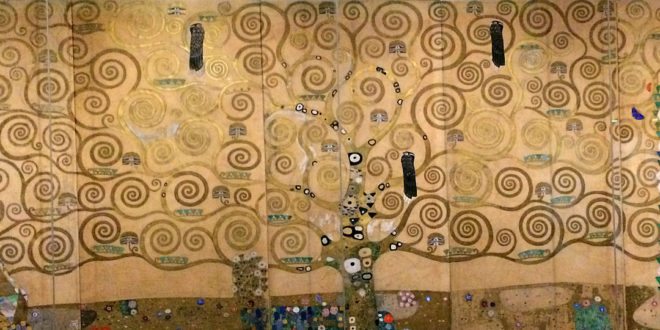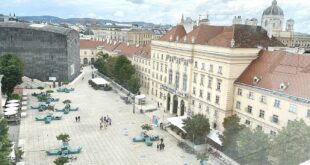Fin De Siecle Vienna. Whether your heart beats for bold patterns or bold ideas, straight lines or straight talking, complex psyches or complex music: a radical mindset is key to enjoying Vienna 1900. I have pulled together a list of the best things to see and do, including the best anniversary exhibitions.
Fin de Siècle Vienna In Brief
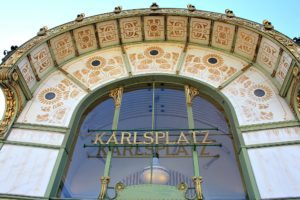
Fin De Siecle Vienna. Hardly anywhere in Europe did artists and intellectuals erode tradition so dramatically as in Wien. And hardly anywhere did they break as radical new ground as there. But exactly how did Vienna Modernism help pull the plug of a 600-year-old Empire in 2018? If you follow key artists, scientists and intellectuals such as Gustav Klimt, Egon Schiele, Otto Wagner, Sigmund Freud, Arnold Schonberg and Ludwig Wittgenstein you will find out.
Best Of Art And Architecture
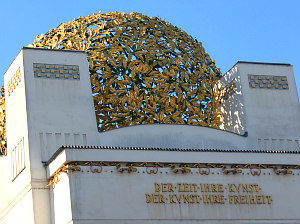 Fin De Siecle Vienna. Known as Wiener Jugendstil, Art Nouveau art and architecture emerged from the Wiener Secession in 1897. Essentially, the radical group of Secessionist artists was determined to break with traditional art and architecture.
Fin De Siecle Vienna. Known as Wiener Jugendstil, Art Nouveau art and architecture emerged from the Wiener Secession in 1897. Essentially, the radical group of Secessionist artists was determined to break with traditional art and architecture.
Rather than continuing to cement power through paintings and buildings, the Secessionists redefined the purpose of art: They wanted it to penetrate all aspects of every day life, from spoons and books to chairs and postal offices.
If you look at the Vienna Secession you can feel the level of radicalism some Viennese were up to.
To Every Age Its Art. To Art Its Freedom. (Wiener Secession)
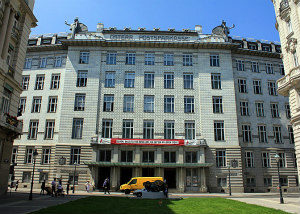 First and foremost, artist Gustav Klimt and architect, designer and urban developer Otto Wagner spearheaded the rebellious movement. What I find most fascinating is how their works gradually evolved from historistic styles to both rich ornaments and simple structures. Just take Gustav Klimt’s early frescoes at Burgtheater: they have little to do with the artwork most are familiar with.
First and foremost, artist Gustav Klimt and architect, designer and urban developer Otto Wagner spearheaded the rebellious movement. What I find most fascinating is how their works gradually evolved from historistic styles to both rich ornaments and simple structures. Just take Gustav Klimt’s early frescoes at Burgtheater: they have little to do with the artwork most are familiar with.
Likewise, it’s hard to believe that buildings so different in style as the Majolikahaus and the Postal Savings Bank both go on Otto Wagner’s account. Learn more about Klimt and Wagner and their best works in Gustav Klimt Artwork and Otto Wagner Vienna.
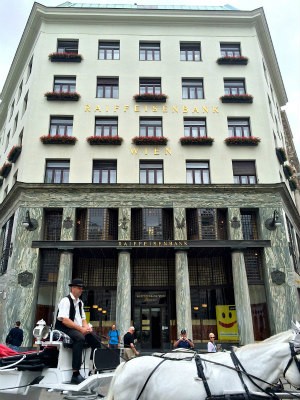 Probably the most controversial architect of Vienna Modernism was Adolf Loos. Although a key figure of the Fin de Siècle Loos critically attacked the Secessionists. Unlike them, he condemned the ornament as an architectural element. Detesting decoration for its own sake he loved straight lines and bleak façades as much as expensive natural materials, like marble, wood and silver.
Probably the most controversial architect of Vienna Modernism was Adolf Loos. Although a key figure of the Fin de Siècle Loos critically attacked the Secessionists. Unlike them, he condemned the ornament as an architectural element. Detesting decoration for its own sake he loved straight lines and bleak façades as much as expensive natural materials, like marble, wood and silver.
This becomes very visible with the Loos House, aka the ‘house without eyebrows’ (photo) opposite Hofburg Palace. Actually, Emperor Francis Joseph was so outraged about the sight that he had the windows of Hofburg facing Loos House nailed.
‘The development of culture is concurrent with the removal of ornaments from objects of daily use.’ (Adolf Loos)
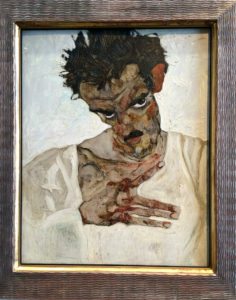 Another enfant terrible of Vienna Modernism was avantgarde painter Egon Schiele. Like his mentor Klimt he loved to draw females. However, far from Klimt’s aesthetics his models exposed their troubled souls on every inch of their bodies and faces.
Another enfant terrible of Vienna Modernism was avantgarde painter Egon Schiele. Like his mentor Klimt he loved to draw females. However, far from Klimt’s aesthetics his models exposed their troubled souls on every inch of their bodies and faces.
Reflecting the tumultuous upheavals of the time, Schiele’s women turned out pale and emaciated. While Gustav Klimt supported Schiele’s style, the catholic Viennese public was horrified and hostile of these ‘most disgusting aberrations that Vienna ever witnessed’.
Characteristically of Fin de Siècle Vienna many of Schiele’s portraits challenged traditional values. Who wanted to be openly confronted with their own moral dilemmas and social scandals through the most provocative visuals? If you want to get to the bottom of a troubled era, do visit the Schiele exhibition at Leopold Museum (aka Egon Schiele Museum).
Wiener Werkstätte
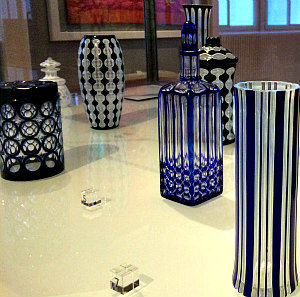 Fin De Siecle Vienna. Especially arts and crafts fans will find a vast source of inspiration in Vienna Modernism. At its centre is Vienna’s famous arts and crafts workshop Wiener Werkstätte.
Fin De Siecle Vienna. Especially arts and crafts fans will find a vast source of inspiration in Vienna Modernism. At its centre is Vienna’s famous arts and crafts workshop Wiener Werkstätte.
The reason this workshop was set up in 1903 couldn’t be more timely: Notably Secession members and co-founders Josef Hoffmann and Koloman Moser wanted to fight the trend of imitating old styles on one hand, and mass producing low quality items on the other hand.
It’s important to realise that the Secession created Wiener Werkstätte to promote the idea of the ‘total artwork’. With incredible creative power, skilled craftsmen modernised and simplified objects of everyday use: from interior design, accessories and fashion to furniture, books and postcards.
Fin De Siècle Highlights And Adresses
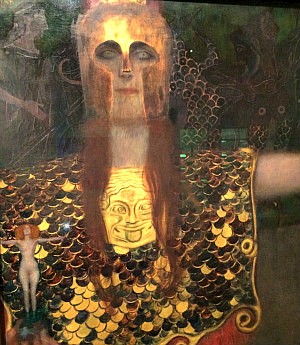 Wiener Secession, Friedrichstrasse 12, 1010 Vienna;
Wiener Secession, Friedrichstrasse 12, 1010 Vienna;- Gustav Klimt collection at Belvedere Vienna, Prinz-Eugen-Strasse 27, 1030 Vienna;
- Leopold Museum at Museumsquartier, Museumsplatz 1, 1010 Vienna;
- Vienna 1900 exhibition, Klimt’s Magic Garden VR installation, and Wiener Werkstätte archive at Museum of Applied Arts (MAK), Stubenring 5, 1010 Vienna;
- Otto Wagner Houses at Linke Wienzeile, no 38 and 40, 1060 Vienna;
- Otto Wagner’s Austrian Postal Saving Bank, Georg-Coch-Platz, 1010 Vienna;
- Loos House, Michaelerplatz 3, 1010 Vienna;
Fin de Siècle Walks and Tours
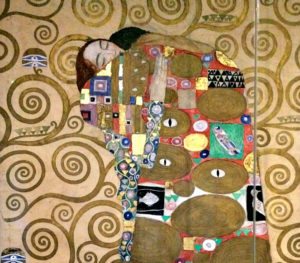
Fin De Siecle Vienna. I have set up an itinerary for a free Vienna 1900 walk that covers these and more highlights in two days.
Alternatively, put yourself in the hands of a savvy private guide/cultural journalist specialising in Modernist Vienna. During your tour you will also listen to modernist music and cover not only art and architecture, but politics, literature, Freud and music. The three hour private tours are available for USD 330. Get in touch for details and availabilities.
Best Of Modernist Music
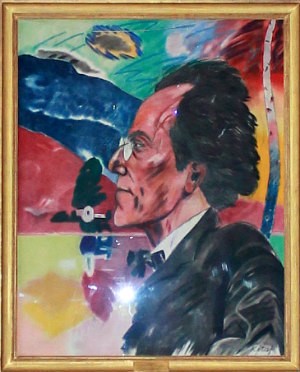 Fin De Siecle Vienna. Generally, accessing modernist art is easier than understanding modernist music. Therefore, once you appreciate the complexities and beauty of Klimt, Schiele and Kokoschka build on your insights when exploring Fin de Siècle music.
Fin De Siecle Vienna. Generally, accessing modernist art is easier than understanding modernist music. Therefore, once you appreciate the complexities and beauty of Klimt, Schiele and Kokoschka build on your insights when exploring Fin de Siècle music.
Start with Austro-Hungarian conductor and composer Gustav Mahler: Like with Klimt, Mahler’s work gradually developed from representing the outside world to expressing personal feelings with all their disharmony and complexity. Essentially his songs and symphonies build a bridge between the Late Romantics and the 20th century.
‘The symphony must be like the world. It must embrace everything.’ (Gustav Mahler)
One of Mahler’s most popular tunes is the Adagietto of his 5th Symphony, give it a listen:
Compared to Mahler, Vienna-born composer Arnold Schönberg will likely appeal to music connoisseurs with deeply analytical minds. In fact, the famous inventor of the 12 tone series (aka serialism) and member of the Second Viennese School wrote music without a using a specific key and tone. Drawing from a row of 12 tones instead of eight, his music created dense sounds without obvious pattern. Therefore, instead of following a tune you are almost bound to reflect on complex combinations of sounds.
Where In Vienna To Experience Modernist Music
Fin De Siècle Vienna. The best concert venue that regularly stages modernist music is Wiener Konzerthaus. To learn more about the life and works of Schönberg visit the small Arnold Schönberg Center on Schwarzenbergplatz 6.
Best Of Intellectual Fin De Siècle Vienna
Fin De Siecle Vienna. Parallel to visualising and musicking the radical ideas of Wiener Moderne, authors and human scientists developed their own radical thoughts. For example, Austro-Hungarian author and writer Karl Kraus spearheaded a group of intellectuals thanks to his influential satirical newspaper Die Fackel (The Torch). That group, called Young Vienna, challenged 19th century morals in favour of social politics, individual freedom, and sexual openness.
‘Psychoanalysis is that mental illness for which it regards itself as therapy.’ (Karl Kraus)
Quite different from Karl Kraus, novelist Arthur Schnitzler not only propagated sexual openness he was leading by example in the most traditional way. In his novel Anatol, Schnitzler portrays an emotionally detached, superficial, and indetermined dandy. In Fräulein Else, in turn, the main character breaks under the moral conventions of her time. Among his most popular novels are Anatol, Reigen, and The Vast Domain.
‘The Soul is a vast domain.’ (Arthur Schnitzler)
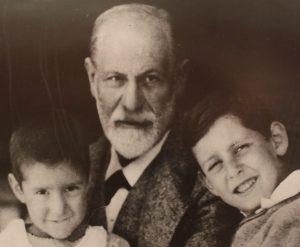 Schnitzler’s interest in psychology and sexuality also made him a close friend of Sigmund Freud. The ‘father of psychoanalysis’ not only developed dialogue-based techniques and dream analysis to treat neuroses, he famously defined the Oedipus complex, libido and the death drive. If you like to follow the traces of Sigmund Freud in Vienna, consider visiting the Sigmund Freud Museum as part of a guided tour.
Schnitzler’s interest in psychology and sexuality also made him a close friend of Sigmund Freud. The ‘father of psychoanalysis’ not only developed dialogue-based techniques and dream analysis to treat neuroses, he famously defined the Oedipus complex, libido and the death drive. If you like to follow the traces of Sigmund Freud in Vienna, consider visiting the Sigmund Freud Museum as part of a guided tour.
As central and controversial as Freud and most other key figures of Vienna Modernism was philosopher Ludwig Wittgenstein. Promoting a philosophy of logics and mathematics, Wittgenstein created new insight into how we perceive the world through thoughts and language. His Tractatus Logico-Philosophicus and his Philsophical Investigations subsequently deal with the meaning of mind, justice, truth and time.
go to Vienna Art Tips for Travellers: From Baroque Period to Vienna Modernism
visit Vienna Tourism Tips – Essentials To Know
back to Vienna Unwrapped homepage
